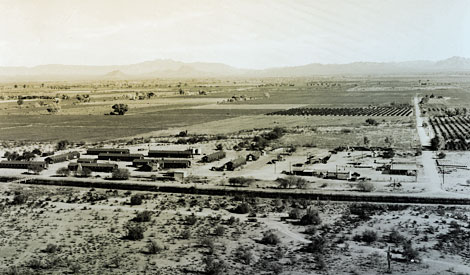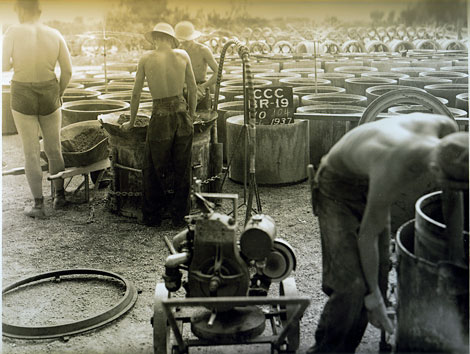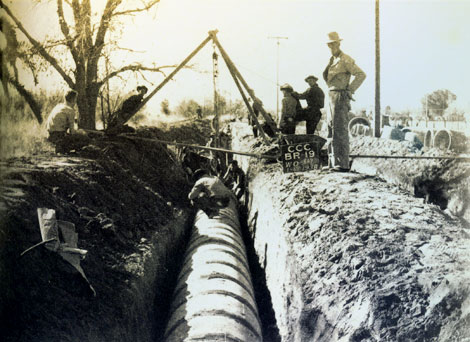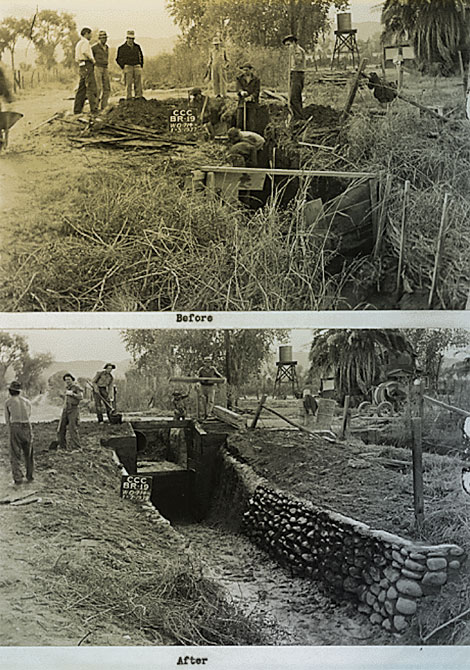

 A view of the Bureau of Reclamation CCC Camp BR-19 in Tempe. The canal in the foreground is the Cross Cut Canal that links the Arizona Canal and Grand Canal. (Reclamation photograph)
A view of the Bureau of Reclamation CCC Camp BR-19 in Tempe. The canal in the foreground is the Cross Cut Canal that links the Arizona Canal and Grand Canal. (Reclamation photograph)By the time the effects of the Great Depression reached the Salt River Valley, it was already in the throes of economic decline. The end of World War I slashed demand for long-staple cotton that had been used for manufacturing military goods. This, combined with a pink bollworm infestation, contributed heavily to the Valley's dire economic situation. A drought in the western states reduced agricultural production. Adding insult to injury, demand for Valley produce fell as the economy struggled. Other sectors of the Arizona economy were also impacted by the Depression, and the overall result was increased unemployment, decreased income, and complete stagnation of the state's economy.
 Camp BR-19 contained a number of facilities to support its work on rehabilitating SRP canals and laterals. In this view, CCC workers are casting concrete pipe for use in piping open laterals. They were able to cast concrete pipe in different diameters to meet a variety of piping needs. (Reclamation photograph)
Camp BR-19 contained a number of facilities to support its work on rehabilitating SRP canals and laterals. In this view, CCC workers are casting concrete pipe for use in piping open laterals. They were able to cast concrete pipe in different diameters to meet a variety of piping needs. (Reclamation photograph)Of the various work projects the federal government established during the Great Depression, one had a noticeable impact on the Salt River Valley. The Civilian Conservation Corps, known as the CCC, recruited unemployed, single men between 17 and 25 years old, whose families were in financial need. The government assigned CCC enrollees to camps around the country to work on federal conservation projects. In 1935, several camps were established in the Valley. Two of these, BR-14 in Papago Park and BR-19 along the eastern side of the Cross-cut Canal in Tempe, were under the jurisdiction of the Bureau of Reclamation and worked exclusively on the Salt River Project (SRP).
 In this 1938 photo, a CCC work crew from Camp BR-19 installs a 30-inch diameter pipe along a lateral known as "Little Maricopa" west of Central Avenue in Phoenix. (Reclamation photograph)
In this 1938 photo, a CCC work crew from Camp BR-19 installs a 30-inch diameter pipe along a lateral known as "Little Maricopa" west of Central Avenue in Phoenix. (Reclamation photograph)The SRP's irrigation infrastructure was over 25 years old, and many of the delivery gates, turnouts, smaller diversion dams, drop structures, and check dams were made of redwood. Years of exposure to Arizona's sun and heat, as well as canal water, had taken their toll on the wooden features. Because of decreased revenues, the Salt River Valley Water Users Association (Association) shifted maintenance priorities. No improvements were being made, and Association crews were constantly busy repairing, cleaning, and assuring the system kept working, even at a diminished capacity.
 This photograph shows the end result of a CCC work crew's rehabilitation of an old, wooden check structure with a new concrete structure. These crews replaced many deteriorated wooden structures with concrete structures. (Reclamation photograph)
This photograph shows the end result of a CCC work crew's rehabilitation of an old, wooden check structure with a new concrete structure. These crews replaced many deteriorated wooden structures with concrete structures. (Reclamation photograph)The majority of the CCC's work consisted of lining dirt laterals with concrete, and removing and replacing deteriorated wooden water control features. The men also participated in the control of gophers along canals and laterals, where the animals' burrowing activities contributed to erosion. A concrete pipe-making plant was build at BR-19, and later a gravel pit was constructed near the Salt River to provide aggregate for making concrete.
BR-14 and BR-19 were closed in March 1938. The camps were dismantled and the materials reused. In less than three years, the men of BR-14 and BR-19 had completed over 700 projects, provided economic support both to the local community and to their families, and rebuilt the Salt River Project's dilapidated infrastructure.
It could be argued that if it were not for the efforts of the CCC, the Valley would not have been as prepared to support the nation when the United States entered World War II. Without the rebuilt infrastructure, it would have taken years for the Valley to get to the level needed to rebound from the Depression and support the country. Instead, the Valley was ready to feed and support the thousands of service men at Luke Air Base, Williams Field, and Thunderbird Field during World War II. Among the long list of benefits, perhaps the greatest benefit to the Valley and ultimately to the Nation was that the men from BR-14 and BR-19, along with thousands of other members of the CCC, were better trained and prepared to support the war effort.
